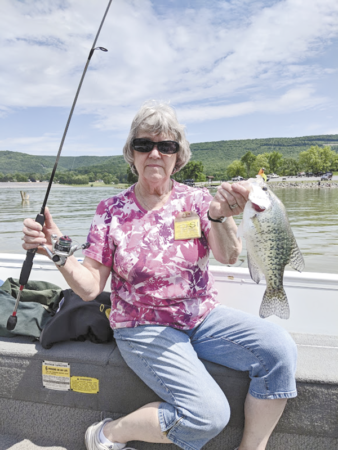May is a “crappie” month; if you heard me verbalize that statement and didn’t see it in written form, you would probably be asking, “What’s his problem?” Well, actually, I don’t have a problem; in fact, it’s quite the opposite — I have anticipation and excitement because May is one of the best months to pursue crappies.
Don’t misunderstand; crappies can be caught literally year-round; they are, after all, a species of panfish we catch in good numbers even in the dead of winter. During the warm, balmy summer months, they can still be taken if you fish deep where suspended schools, once located, can provide great action.
What’s great about May is that crappies are in spawning mode, and that means they can be found in shallower water in good numbers, and they are active feeders during this period.
First, a little background. Crappies are a part of the sunfish family, along with the common bluegill. They are similar in size and shape to a bluegill or rock bass, but they are more silvery with black markings; there is no other color. We actually have two separate species of crappies, the black crappie, and the white crappie. Believe me, many anglers have difficulty telling the difference between the two, but an excellent place to start is to look at the dark markings on the sides.
On a black crappie, the small dark blotches are scattered randomly all over the side, but on a white crappie, the dark markings tend to form a series of vertical bars. Be aware, however, that different water colors can make the dark markings far less visible. Another difference is on a white crappie, the distance from the eye to the beginning of the dorsal fin is greater than the length of the dorsal fin base. On a black crappie, the distance from the eye to the beginning of the dorsal fin is equal to the length of the dorsal fin base.
Black crappies are more common in our area, although white crappies will also show up. Spawning begins when water temperatures hit the lower 60s. Crappies tend to spawn in 2-10-foot depths, but they have been found to spawn deeper. Bigger crappies tend to spawn deeper. Crappies are especially fond of wood stick-ups and other wood structures, but weeds and weed edges are also good places to find crappies. Don’t overlook any kind of structure, including rocks and the edges of drop-offs and points. Keep in mind that crappies often suspend, especially when they return to deeper water after spawning.
Most often, if you can find them, you can usually garner some action. They have big enough mouths to take minnows, worms, and lures that imitate natural baits. I rarely go to the trouble to get live bait since I can get plenty of action on small lead head jigs with some type of plastic grub like a Berkley Power grub or a small split tail plastic grub. I like white, but I’ll experiment a bit to find what color seems to work best at the time.
Last week, my wife and I had plenty of action using the eighth once lead heads and plastic grubs fished at various depths. We use ultralight outfits with a four-pound test and keep a tight line to feel the strike. If you prefer, you can also use an adjustable bobber or float to control the depth and to indicate a strike.
Make sure you are fully aware of the regulations regarding the keeping of crappies; how many — and what size they have to be — varies from lake to lake. I do keep some crappies for the frying pan, but regardless of how many I may catch, I usually limit my take to about a dozen; twenty or so fillets makes a good meal for my wife and me. And yes, they are an excellent dish, both fried and baked. Even my 95-year-old mother looks forward to a meal of crappies when we visit.





Leave a Comment
Your email address will not be published. Required fields are marked with *